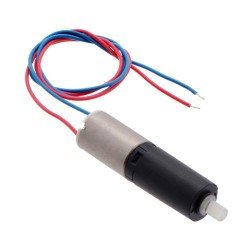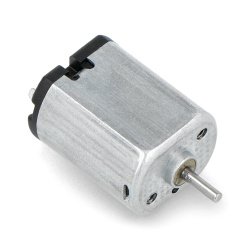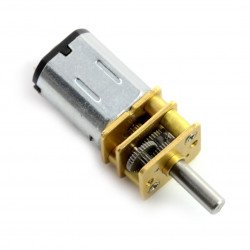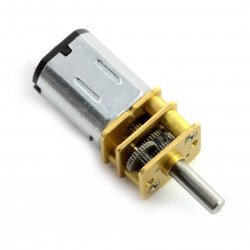DC motors are used, among others, in industrial automation systems, household appliances, power tools, car components, electric gates, as well as in robots. In our offer you will certainly find a DC motor with parameters that meet the needs of your project !
How are DC motors constructed and how do they work?
The basic elements of the construction of a classic DC motor are permanent magnets forming the stator and windings connected to a package of copper sheets that form the rotor . The rotor is powered by carbon brushes that are in contact with a commutator formed by the rotor blades. When the rotor winding is connected to voltage, a current flows through it, which creates a magnetic field that causes the rotor to rotate due to interaction with the stator magnetic field. When the rotor windings are in a position parallel to the stator magnetic field lines, the commutator switches the polarity of the supply voltage, which results in the reversal of the direction of the magnetic field in the rotor circuit, maintaining its rotation continuously in one direction. In this way, the DC (direct current) motor is set in motion and drives the moving elements.
DC commutator motors - a simple design with many advantages
The simple design and repeatable production technology of DC commutator motors and their affordable price have made these machines popular in many hobby and professional applications. You can power DC motors with DC voltage from a battery or AC adapter . The higher the supply voltage, the higher the engine speed. Reversing the polarity of the battery or power supply will change the direction of motor rotation. If your application requires motor speed control, it is definitely worth choosing a PWM controller that allows smooth regulation of motor speed in the full range. The advantages of DC motors include high torque already in the lower speed range - even when the motor is mechanically loaded, it will be able to quickly achieve the required speed.
What factors should be considered when selecting a DC motor?
When selecting a motor for a specific project, you must take into account its most important rated parameters , i.e. supply voltage , current consumption , torque and rotational speed . The value of the supply voltage determines the effect in the form of required torque at the appropriate speed. Applying too low a voltage to the motor brushes will prevent the motor from starting, and applying too high a voltage than recommended by the manufacturer may result in too high a current flowing in the rotor circuit, which will be manifested by too strong electrodynamic and thermal influence, leading to permanent damage to the rotor and even the stator. Increasing the load on the motor shaft increases current consumption from the power source - in the case of engines operating with heavy loads, it is worth using an additional radiator that increases the heat dissipation surface. The engine speed must be selected according to the application requirements. Engines achieve their greatest efficiency at the highest rotational speed. Adding a gear reduces the engine speed. The torque on the engine shaft or the gear driven by it is a quantity that directly affects the engine's acceleration and its ability to be used in a specific application.
DC motors - direct current - FAQ














































































































































































































































































































































































